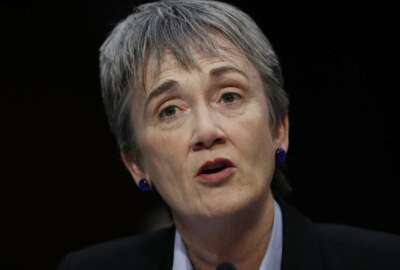In the midst of intensifying space operations and threats, the Air Force is increasing its initial training for airmen specializing in space from 77 days to 111 days, starting next October.
Airmen involved in the training will also have to procure a top secret security clearance before they can begin certain parts of their curriculum. Currently, airmen only need a secret designation for space training.
The elongated training will incorporate a greater depth of knowledge on threats like cyber and will require trainees to identify physical threats by sight.
“If I’m an F-16 pilot I know threats by visual. They throw up charts and go ‘What’s that?’” said Brig. Gen. DeAnna Burt, director of operations and communications at Air Force Space Command, during an Air Force Association event Friday in Washington. “The intel community trains their pilots to that level. We need that same training in space, in regard to space threats, which is why we need the top secret clearance.”
The training will have a capstone event at the end of the program where trainees will apply everything they’ve learned over the course.
Burt said the expansion of the training will take a full year because of all the technicalities.
“It’s going to take us that long because you have sensitive compartmented information facilities, you have clearances, these are new accessions, we’ve got to work with the personnel center on how to manage and get folks briefed before they show up,” Burt said. “What’s taking us some time is the process to make sure it’s repeatable and successful.”
The extended training comes as the Defense Department is setting up its own U.S. Space Command and demand for space operators is coming from the combatant commands.
Burt said she is not worried about the recruiting aspect of filling the ranks, or even the retention aspect, because the Air Force has a robust reserve component that specializes in space.
The main worry is the actual throughput of airmen through space training, especially since the Air Force is bumping up the training security level to top secret.
The service had a 79,000-case security clearance backlog in March, according to congressional testimony from Air Force Secretary Heather Wilson.
“That’s my biggest concern, is how quickly I can get them the clearance they need to then take the course,” Burt said.
The Air Force will put most of the top secret criteria toward the end of the course so airmen can work through the class while their clearance is being processed.
Another concern revolves around the number of people interested in STEM. Airmen who want to be space operators must have a STEM degree. Burt said she hopes students will continue their interest in science education.
She said she has hope that renewed interest in space travel, like SpaceX’s plans for manned missions, will inspire young people to pursue STEM.
Space rules of engagement
As space becomes a more contested domain, the United States and the world are still figuring out the rules.
“Everyday in the [geosynchronous earth orbit] belt we live about a degree apart and we are all station keeping,” Burt said. “What is the pattern of life? What do I look like? Is that normal that I’m drifting very close to you? Or am I just a crappy station keeper? Or do I have intent? Am I not just a satellite and I’m something that can do harm to you?”
Burt said the nation is not discussing what is hostile and what is normal when it comes to operations in space.
“We have a lot of international law and various rules of how we traverse the seas in peaceful times, and in wartime how those rules change. We have that in the air domain when we talk about air traffic,” Burt said. “We don’t yet have them in space and we are having that debate today.”
Copyright
© 2024 Federal News Network. All rights reserved. This website is not intended for users located within the European Economic Area.

